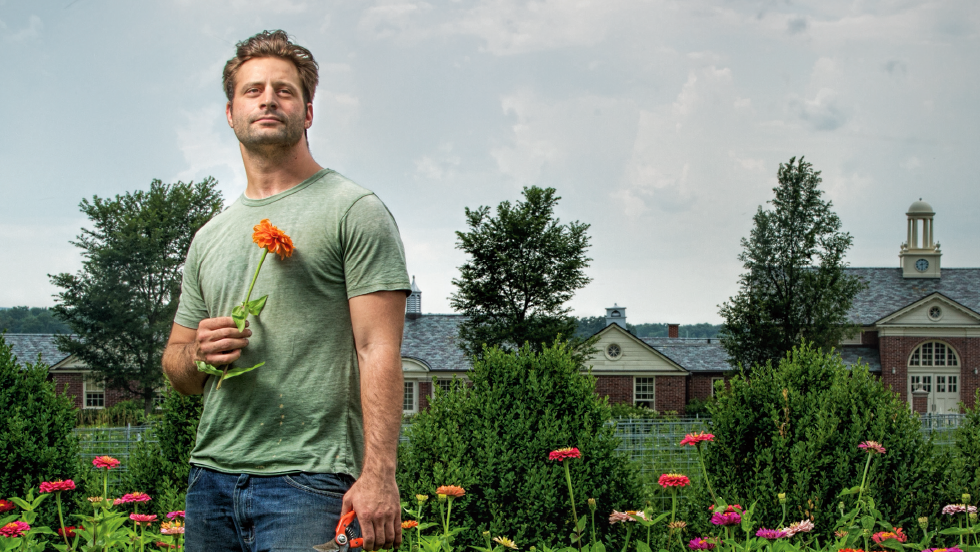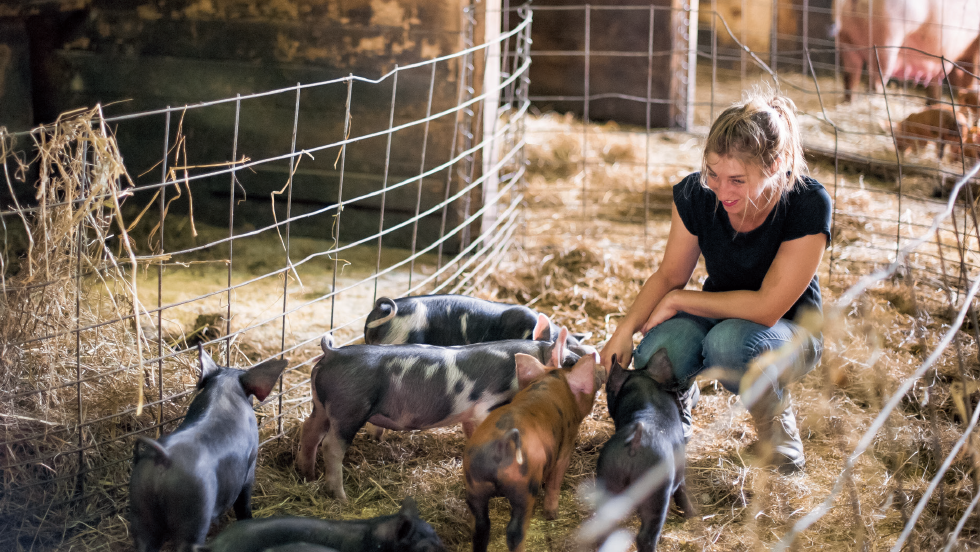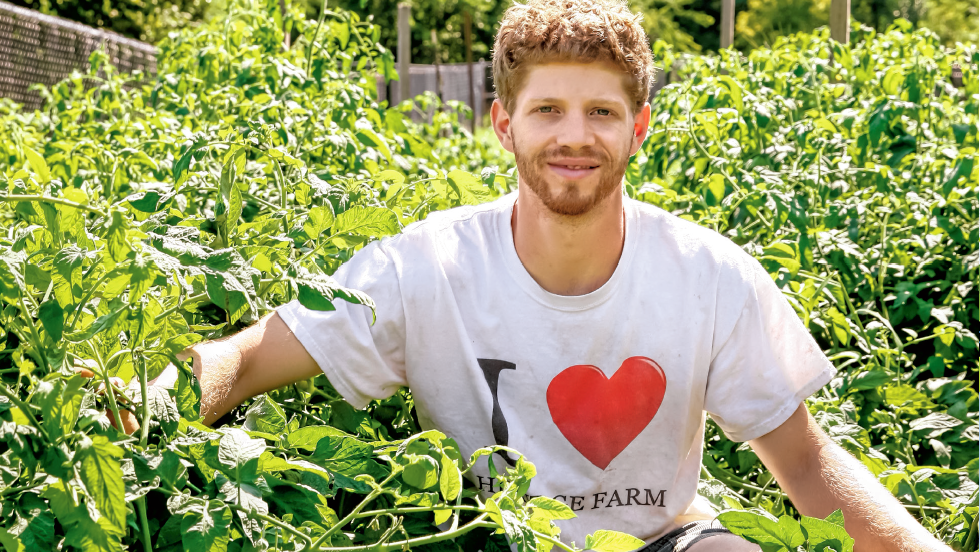Creating the Campus
After a decade of intense construction, Kenyon’s master plan gets a remodel of its own.
Read The StorySet aside the stereotype of the farmer as a man wearing overalls and a straw hat, perched atop a tractor by a cornfield. More than ever, farming attracts a varied lot — including a number of Kenyon alumni.
Story by Robin Davis
Straight Creek Valley Farm is as peace-filled as its owner, Christine Tailer ’76. The sixty-three acres, including a rushing creek lined with trees and filled with blue gill and bass, lie along a gravel-topped country road about fifty-five miles east of Cincinnati, Ohio. Goats, rabbits, and chickens roam the property, which also features bee hives, a “sugar shed” for processing the honey and maple syrup, and fields of vegetables, buckwheat, and alfalfa.
Tailer never set out to be a farmer. She and her husband (pictured above) just bought a piece of land as a kind of weekend retreat after their kids were grown. Little by little, they started backing out of their “city life,” realizing they preferred the country refuge with none of the amenities—no electricity, no phone lines—to their six-bedroom, three-and-half-bath luxury home in Cincinnati.
“We were tired from our city jobs,” said Tailer, who worked as a litigation attorney for twenty-four years. Her husband, Greg, had worked for just as long as a mechanical designer. They eventually quit their jobs, sold their suburban home, and moved full-time to the tiny cabin on their property, where they raise enough food to eat, as well as some to sell and make a small profit.
Farming has taken on a certain appeal in recent years, with the New York Times reporting that agriculture is seen as “trendy” among today’s college graduates. USA Today notes that enrollment at agriculture-centric schools such as Pennsylvania State University is up by as much as 40 percent. Farmland prices have tripled in the last decade, and the U.S. Department of Agriculture National Institute of Food and Agriculture predicts an increase in jobs on the business end of farming as people find opportunities to fill the consumer demand for safe and local food.
“Questions of food and agriculture have become central to a national dialogue,” said Howard Sacks, professor of sociology and founder of the Kenyon Rural Life Center. “Food, what we eat, whether you’re talking about food-related illnesses from childhood to adulthood or you’re talking about food security: these are now issues in the public eye.”
Kenyon counts its fair share of alumni as farmers, though the definition of “farmer” can vary as much as the soil. Some have taken over generations-old family farms growing traditional crops like corn and soybeans. Others, like Tailer, just want to live off the grid and on the land.
“The only places where you could learn about agriculture before were big ag schools,” said Sacks, who lives on a small farm in Mount Vernon. “And I think that’s really a problem, because to really understand agriculture you have to understand it holistically. I think a liberal arts environment is wonderfully suited to address issues of agriculture.”



Kenyon, with its location in the heart of Ohio farm country, is particularly well situated for those interested in studying agriculture from a liberal arts perspective. In 2012, the College purchased a ten-acre farm—aptly named Kenyon Farm—that’s now run by students who live on the property, raising chickens and turkeys, and growing crops that find their way into meals served in Peirce Hall.
“We have embraced our location in a rural community,” said Sacks. “We see connecting to the surrounding community as having great educational value and also a great value for the sustainability of the community.”
There’s an old notion “that a farmer is a farmer is a farmer,” said Adrian Galbraith-Paul ’12, who works as the farm manager at an urban farm in Philadelphia. “It’s not totally true. Farming is incredibly diverse.”
Kenyon’s alumni farmers reflect that diversity.
Sure, Jesse Rosenbluth ’07 grows vegetables as the garden manager at Elawa Farm in Lake Forest, Illinois, a nonprofit public-private sustainability project. But half of the property is dedicated to growing flowers, both as a way to restore the gardens and also to sell as bouquets.
“I’ll always have a soft spot for vegetables. There’s just something wonderful about a little bunch of radishes,” said Rosenbluth. “But when you do flowers, they’re incredible. People love flowers.”
He’s been farming for the last six years, but he’s not sure he’ll continue much longer. “There are a lot of barriers to being a farmer, especially for young people,” he said. “The three things you need to be a farmer are land, access to loans, and cash—lots of it. Young people don’t have it.”
Of the 7,000 pounds of fruits and vegetables Adrian Galbraith-Paul ’12 grows, he loves his tomatoes the most. Tiny Sun Golds and Sun Greens, hefty Brandywines and Black Crimsons, Green Zebras and Great Whites—he grows them all, on the second largest urban farm in Philadelphia.
Heritage Farm, a four-acre operation on the city’s west side, falls under the Methodist Services nonprofit umbrella. The property contains housing for children out of foster care and women transitioning from homeless or battered-women shelters. Twenty-five percent of the food Galbraith-Paul grows goes to these residents. The remainder is sold to the public and restaurants.
Galbraith-Paul works as the farm manager and also handles the grounds maintenance, cutting the grass and managing other plants around the facilities. In addition, he oversees what’s grown in the farm’s three hoop houses, unheated greenhouses that extend the growing season. His work makes a tangible difference to the residents and the community at large every day—which is why he does it.
He came to Kenyon with an interest in politics, but the more he studied the political system, the less he liked it. Environmental issues grabbed his attention (he ended up with a major in political science and a concentration in environmental studies) and led, ultimately, to an interest in urban farming.
It kind of just struck me as a place where you could have a vast impact. You work with nutrition, access to food, become a job creator, create a sense of community."
Adrian Galbraith-Paul '12
After graduation, he met Jack Goldenberg ’09, who was working in Philadelphia as a chef by night and growing vegetables on urban lots by day. Galbraith-Paul worked with him for a year before moving to Heritage Farm. He admits he had to learn the actual tasks of farming on the fly. “For a while I felt like I didn’t know anything,” he said. So he read all he could and talked to people in the business. “There’s definitely a learning curve.”
He focuses more on his short-term goals than any long-range plans, though he suspects food or farming, in some form, will be part of his future. “My goal is to learn as much as I possibly can in the next two to three years, make a lot of connections,” he said. “The thing about living in a big city, you’re surrounded by people who are really interested in food.”
The House family has been in agriculture in Payson, Illinois, for five generations, starting in the 1830s with 160 acres. A.J. House ’80, the youngest of three children, went to boarding school in Massachusetts, then to Kenyon for an undergraduate degree, but he always knew he’d head back to Illinois. Farming was more than the family business; it was his business.
The House farm, in which both his sister and brother have equity but not control, is spread over four parcels now, encompassing several thousand acres. It may be what most people would consider a “large” farm, but House says, with Midwestern realism, “There’s always a bigger fish in the pond.” In fact, the family farm once embraced more than triple its current acreage, but as members married and had children, plots were split and, in some cases, sold off. “My father never sold an acre,” House said, but his uncle sold his shares to concentrate on grouse hunting in Scotland. “You see that all the time on Wall Street, too. People want to cash out and live the good life.”
House, who married Kenyon alumna Lynn Prothro House ’80 in 1990, grows corn and soybeans and operates two cow-calf operations—herds of adult female cows whose calves, after weaning, are sold to feedlots, where they mature. He also has a mining business in southern Illinois, that extracts high-purity limestone used primarily as a fire extinguisher in mines.
He appreciates the romantic notions that some people entertain about farming, whether they seek to live “off the grid” or want to start a hobby farm with just a few animals. “If you talk to people and just mention you live on a farm, they’ll tell you the best summer they ever had was one they spent on a farm,” House said. His own attachment, however, is more focused. “We’re in it for a business,” he said. “From our perspective, it’s agribusiness.”
When he was choosing a college, however, he never considered an agriculture school. “You can get that type of education anywhere. You can even self-educate,” he said. “Clarity of thought and expression is harder to do. That’s one of the beauties of a liberal arts education.”
Farming, he says, is a difficult business, but it provides rewards other industries don’t. “The advantage I see of agriculture, you don’t have the peaks and valleys you have in many industries,” he said. Despite business cycles and price fluctuations, House sees farming as relatively stable. “You don’t have these unbelievable returns one year and then wonder what happened the next year. It’s pretty steady.”
And it is the clarity of thought he learned at Kenyon that allows him to look beyond the no-nonsense aspects of his career choice. “It’s a great way of life. I live in the only house I’ve ever lived in,” he said.
Christine Tailer ’76, who grew up in New York City, chose Kenyon for its rural location—it resembled the boarding school she attended in Connecticut. But “location” meant setting, not the roots of a potential life choice. “In the seventies, agriculture wasn’t a thing that my generation or my peers were looking at,” she said. She double majored in anthropology and psychology, then went on to law school at the University of Cincinnati, where she fell in love with litigation.
She says she backed into her full-time rural life. She and her husband, Greg, started as weekend gardeners and beekeepers, leasing the nine acres of farmable land on their property to a traditional farmer—who used pesticides that, in turn, killed their bees. So they took the land back little by little and began farming it themselves.
They moved into the 388-square-foot cabin on the property in 2007, intending to build a larger, modern house. But they learned that it would be too expensive to bring in electricity or phone lines (though they were able to tap into a county water line), so they added solar panels along with a propane fridge, wood stove, and fire pit. The house contains a loft, where she and Greg sleep. They’re building a bedroom downstairs, however, anticipating that the loft ladder will become more difficult to negotiate as they age. The change breaks her heart a little. “It’s so perfect as it is.”
Both Tailer and her husband have set up part-time online businesses, in law and design respectively, to help with cash flow. But they consider themselves full-time homesteaders. They no longer go to farmers’ markets to sell their harvest, which includes basil, broccoli, kale, eggs, and eggplant. They let customers come to the farm instead, which seems to be enough. “We’re submarining. We live low. There’s not much we need.”
After a decade of intense construction, Kenyon’s master plan gets a remodel of its own.
Read The StoryDelving into the history of design and material culture, a journalist-scholar discovers the humble dinner dish…
Read The Story